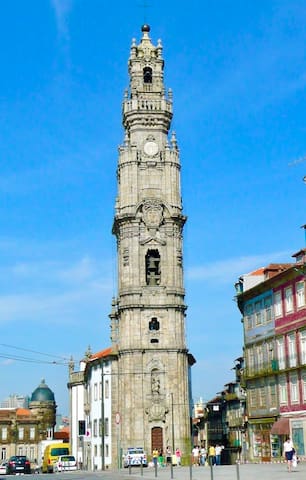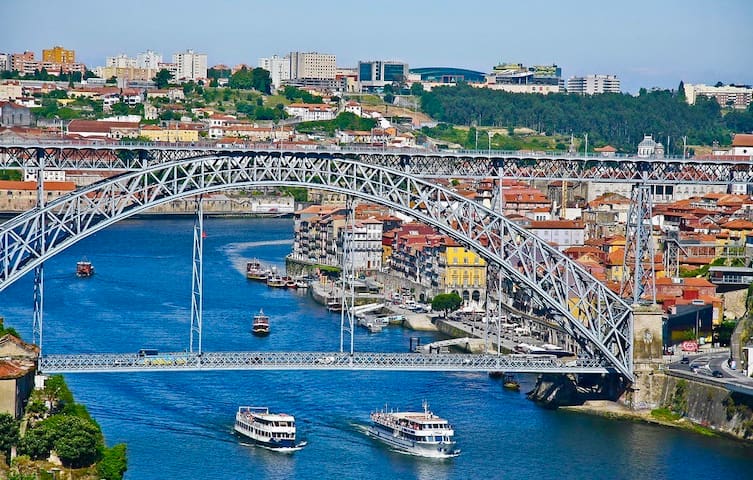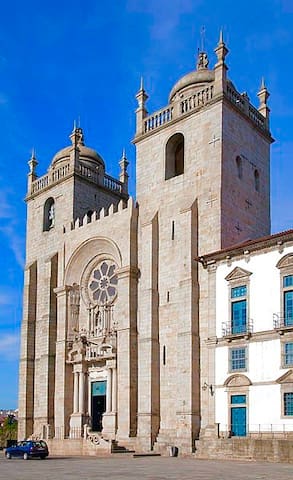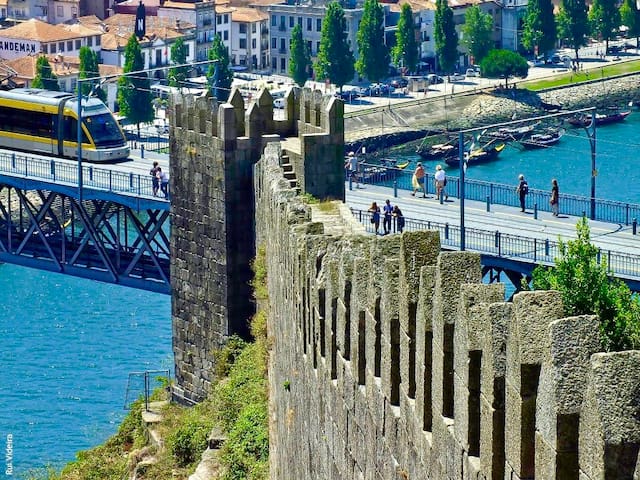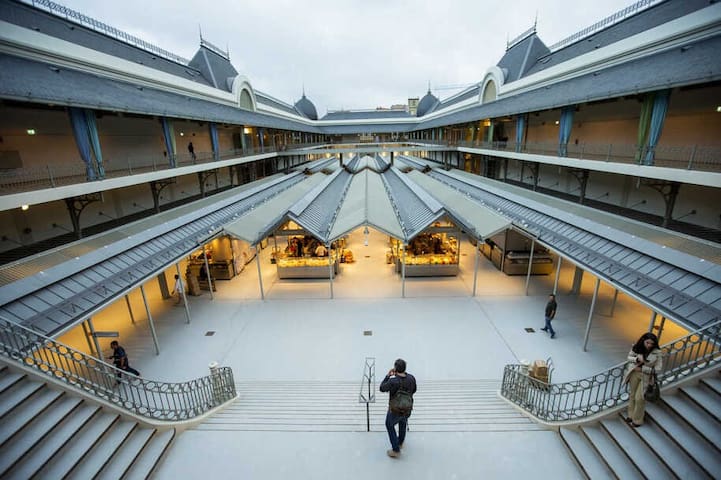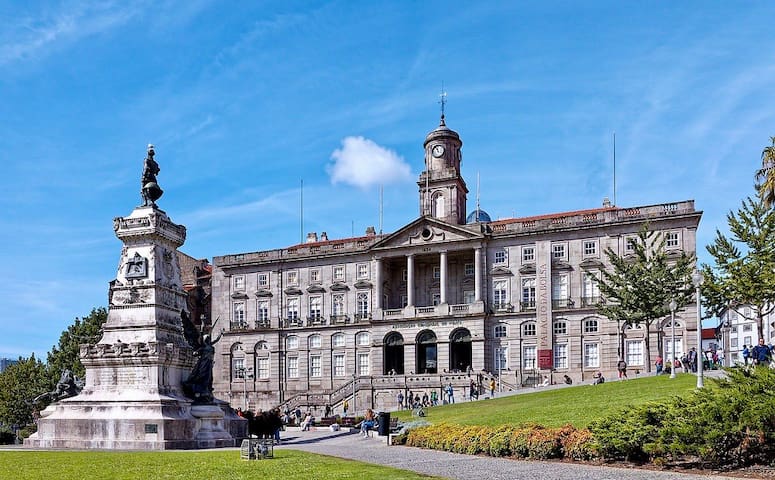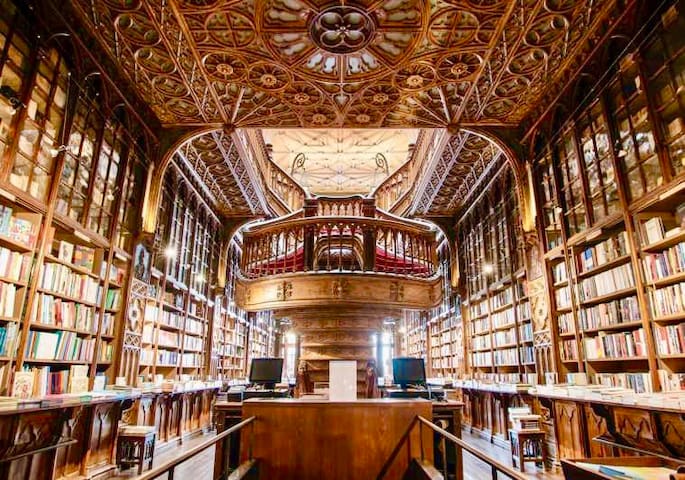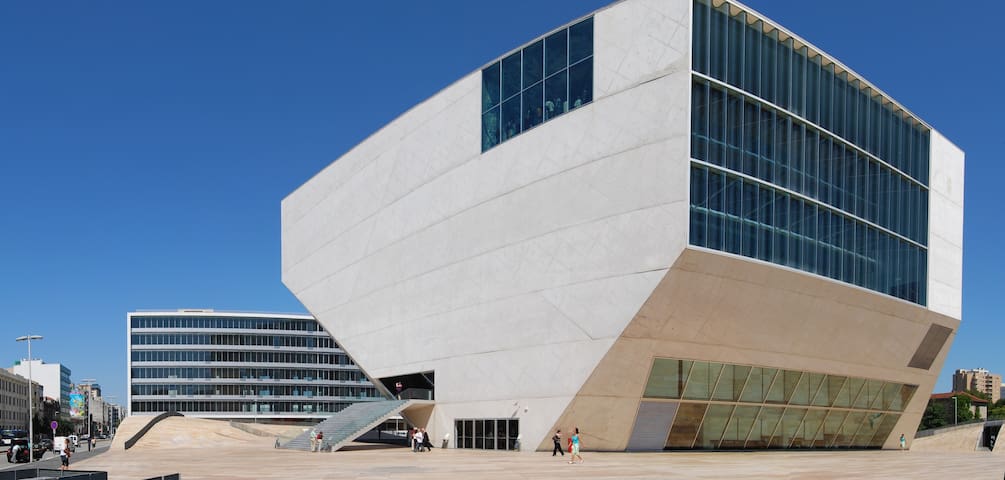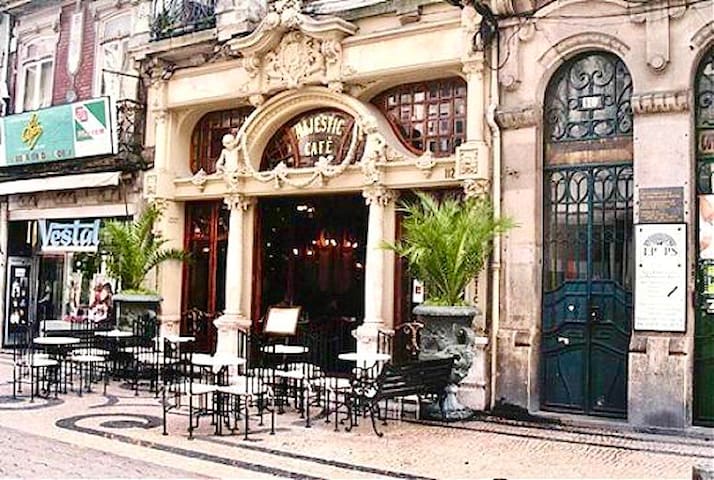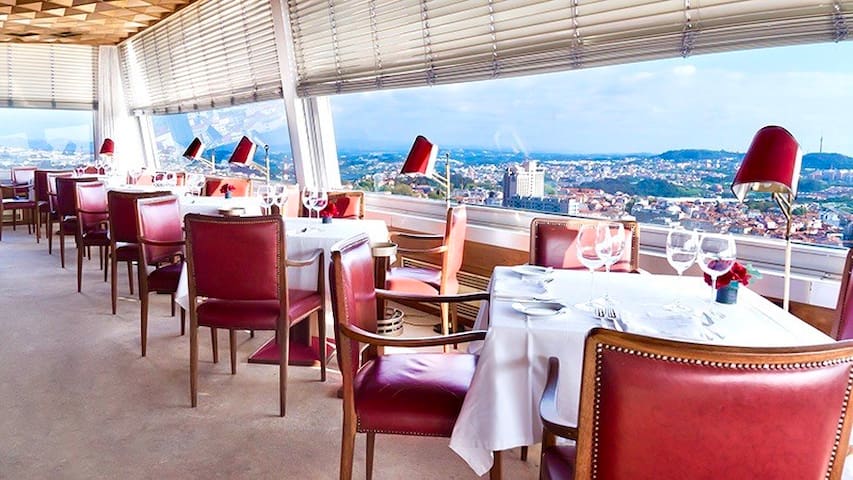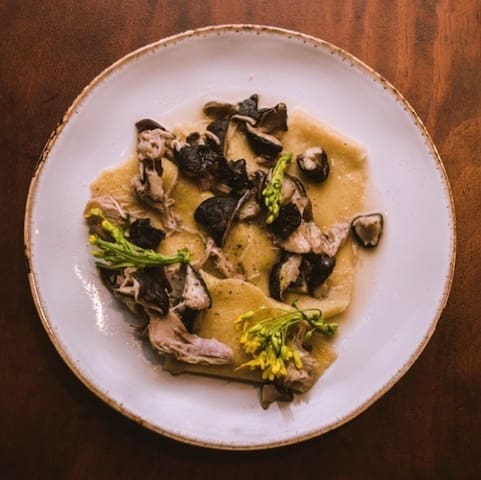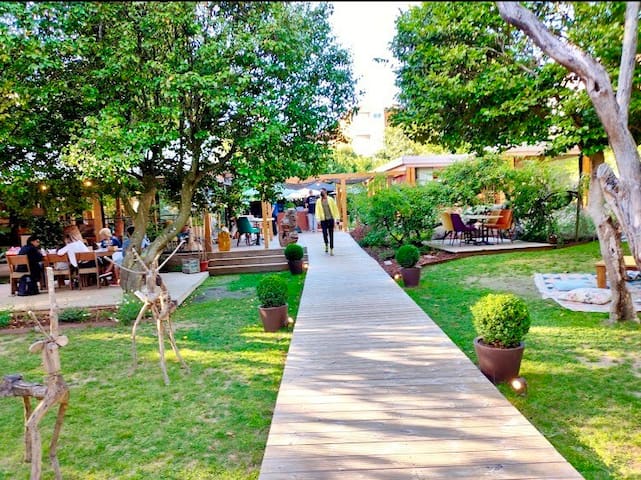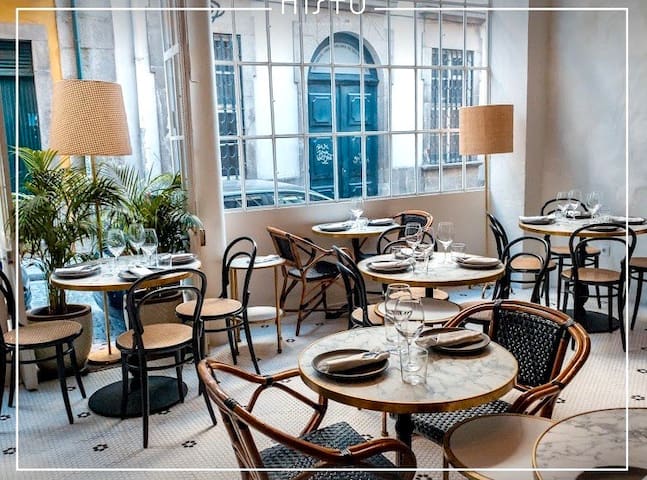. P O R T O Guide
Porto, an unmeasured city to love in an unmeasured way. Porto out of the obvious that is very worth knowing. Shall we go?
Welcome to the vibrant and charming city of Porto, a destination that overflows with history, culture, art, music, gastronomy, leisure and much more! Get ready to explore a place where tradition meets modernity, where history blends with contemporary creativity. On this journey, we will unveil the secrets of this multifaceted city, full of magnificent restaurants, bars, and countless other surprises. This tour guide will be your passport to discover the beating heart of Porto, a place where senses are sharpened, experiences are unforgettable, and memories are created around every corner. Get ready for a journey full of charm, flavor, melodies and discoveries. Let's embark on this unforgettable adventure through the cultural, artistic and gastronomic treasures of Porto!
The Church and “ Torre dos Clérigos “ (18th century) is a remarkable architectural complex located in the city of Porto and is considered the postcard of the city.
Designed by architect Nicolau Nasoni, this set is one of the most notable examples of the late-Baroque style in Portuguese territory and has been classified as a National Monument since 1910. It is considered Nasoni's most emblematic work, incorporating, in granite ornamentation, "a dynamic morphology along with lines of vernacular continuity, if not epimaneirista". The most striking architectural elements of the set are characterized by the irregularity and exaggeration of the forms, which give rise to a surprising scenic effect. It is noteworthy the irregular plants, the wavy facades, highlighted by a counterposition of protrusions, balconies and recesses, interrupted arches, and a great profusion of various windows, complemented by the lush bell tower.
Nasoni was buried in this church, in which he dedicated a lot of time and dedication, having been revealed, in the extensive rehabilitation carried out recently, a crypt where his grave can be found.
1226 residents recomanen
Torre dels Clérigos
Rua de São Filipe de Nery The Church and “ Torre dos Clérigos “ (18th century) is a remarkable architectural complex located in the city of Porto and is considered the postcard of the city.
Designed by architect Nicolau Nasoni, this set is one of the most notable examples of the late-Baroque style in Portuguese territory and has been classified as a National Monument since 1910. It is considered Nasoni's most emblematic work, incorporating, in granite ornamentation, "a dynamic morphology along with lines of vernacular continuity, if not epimaneirista". The most striking architectural elements of the set are characterized by the irregularity and exaggeration of the forms, which give rise to a surprising scenic effect. It is noteworthy the irregular plants, the wavy facades, highlighted by a counterposition of protrusions, balconies and recesses, interrupted arches, and a great profusion of various windows, complemented by the lush bell tower.
Nasoni was buried in this church, in which he dedicated a lot of time and dedication, having been revealed, in the extensive rehabilitation carried out recently, a crypt where his grave can be found.
Ponte Luiz I “ > The real name of this bridge is Luiz I and not, as it is popularly called, Dom Louis I. A sentimental issue of the people of Porto seems to be at the origin of the name by which it is commonly known. Regardless of the name, it constitutes an ex-libris of the city and has been included in the area classified as a World Heritage Site by UNESCO since 1996.
The work of the double-decker bridge was awarded on November 21, 1881 to the company Société Willebreck, Brussels, of which Théophile Seyrig, disciple of Gustave Eiffel, and author of the project of the new bridge, was administrator.
The works began that same year and took place until 1887.
On May 26, 1886, the first tests of the bridge were carried out, subjecting it to loads of 2,000 kg per linear meter of beam. On October 30, 1886, the construction work of the arch and the upper board ends; on October 31, 1886 the upper board of the bridge is inaugurated and in 1887 the lower deck is inaugurated, with which the construction works of the new bridge are completed.
It was a toll bridge instituted, the day after the inauguration of the upper board, on November 1, 1886 and that would only cease to be charged on January 1, 1944, that is, almost 58 years later.
Some data: Arch with 172 m, Top board with 392 m in length and the bottom with 174 m in length.
585 residents recomanen
Pont Luís I
Ponte Luís I Ponte Luiz I “ > The real name of this bridge is Luiz I and not, as it is popularly called, Dom Louis I. A sentimental issue of the people of Porto seems to be at the origin of the name by which it is commonly known. Regardless of the name, it constitutes an ex-libris of the city and has been included in the area classified as a World Heritage Site by UNESCO since 1996.
The work of the double-decker bridge was awarded on November 21, 1881 to the company Société Willebreck, Brussels, of which Théophile Seyrig, disciple of Gustave Eiffel, and author of the project of the new bridge, was administrator.
The works began that same year and took place until 1887.
On May 26, 1886, the first tests of the bridge were carried out, subjecting it to loads of 2,000 kg per linear meter of beam. On October 30, 1886, the construction work of the arch and the upper board ends; on October 31, 1886 the upper board of the bridge is inaugurated and in 1887 the lower deck is inaugurated, with which the construction works of the new bridge are completed.
It was a toll bridge instituted, the day after the inauguration of the upper board, on November 1, 1886 and that would only cease to be charged on January 1, 1944, that is, almost 58 years later.
Some data: Arch with 172 m, Top board with 392 m in length and the bottom with 174 m in length.
Porto Cathedral - The beginning of its construction dates from the first half of the 12th century, and lasted until the beginning of the 13th century. This first building, in Romanesque style, has undergone many changes over the centuries. From the Romanesque era date the general character of the facade with the towers and the beautiful rose window, in addition to the body of the church of three naves covered by cannon vault. The vault of the central nave is supported by flying buttresses, with Porto Cathedral being one of the first Portuguese buildings in which this architectural element was used.
In Gothic times, around the year 1333, the funeral chapel of João Gordo, knight of the Order of Hospitallers and collaborator of D. Dinis, buried in a tomb with a jacente. Also from Gothic times dates the cloister (14th-15th century), built in the reign of D. John I. This king married D. Philippa of Lancaster at the Cathedral of Porto in 1387.
The exterior of the Cathedral was greatly modified in the Baroque era. Around 1736, the Italian architect Nicolau Nasoni added a beautiful Baroque gallilé to the side facade of the Cathedral. Cerc of 1772 a new portal was built to replace the original Romanesque. The balustrades and domes of the towers are also baroque.
To the left of the main chapel is a magnificent silver altar, built in the second half of the 17th century by several Portuguese artists. This was saved from French troops in 1807 by means of a hastily built plaster wall.
Still in this left area is especially remarkable the medieval image of Our Lady of Vandoma, (patron saint of the city).
In the 17th century the original Romanesque main chapel (which was equipped with an ambulatory) was replaced by a larger one in the Baroque style. The high altar, built between 1727-1729, is an important work of the Johannine Baroque, designed by Santos Pacheco and carved by Miguel Francisco da Silva. The mural paintings of the main chapel are by Nasoni. The southern transept gives access to the cloisters of the 14th century and the Chapel of St. Vincent. A graceful 18th-century Nasoni staircase leads to the upper floors.
The Cathedral has 3 beautiful organs. One of them, in the high choir, marks in Portugal a period that begins organistic development. It is an instrument of the builder Jann, the same as the organ of the church of Lapa (Porto). > In this Cathedral are the patron saints of the city of Porto, the current one being Our Lady de Vendôme. The devotion has its origin in an episode known as Armada dos Gascões, which occurred in Portugal during the period of the Christian Reconquest of the Iberian Peninsula. It may have appeared around the year 990, at a time when the Portuguese nobleman Munio Viegas led an armada of knights from Gascony who, when disembarking at the mouth of the Douro River, fought the Moors who dominated the Porto region. Along with the Gascons, was Dom Nónego, bishop of the French locality of Vendôme and who later went to Porto, who, it is believed, had brought with him a copy of the image of Our Lady that was in the Cathedral of Vandoma (Vendôme).
According to tradition, Monsignor Munio and the French, after the victory over the Moors and the resumption of the city, re-erected the city walls. These had, as one of the main exits, the so-called Porta de Vandoma, where the aforementioned image of Our Lady of Vendôme, currently exhibited in the Cathedral of Porto, would have been placed.
The city consecrated Our Lady of Vendôme as its patron saint, a devotion that, to this day, illustrates the coat of arms of Porto.
The image was venerated by the population, which led it to walk through its streets in procession, especially during the periods of epidemics that devastated Porto and neighboring regions.
Devotion arrived in Brazil by the Portuguese as Nossa Senhora do Porto (Our Lady of Vendôme), which also became the patron saint of some cities such as Andrelândia and Senhora do Porto, in Minas Gerais region and Morretes, in Paraná region.
566 residents recomanen
Catedral de Porto (Se Catedral)
Terreiro da Sé Porto Cathedral - The beginning of its construction dates from the first half of the 12th century, and lasted until the beginning of the 13th century. This first building, in Romanesque style, has undergone many changes over the centuries. From the Romanesque era date the general character of the facade with the towers and the beautiful rose window, in addition to the body of the church of three naves covered by cannon vault. The vault of the central nave is supported by flying buttresses, with Porto Cathedral being one of the first Portuguese buildings in which this architectural element was used.
In Gothic times, around the year 1333, the funeral chapel of João Gordo, knight of the Order of Hospitallers and collaborator of D. Dinis, buried in a tomb with a jacente. Also from Gothic times dates the cloister (14th-15th century), built in the reign of D. John I. This king married D. Philippa of Lancaster at the Cathedral of Porto in 1387.
The exterior of the Cathedral was greatly modified in the Baroque era. Around 1736, the Italian architect Nicolau Nasoni added a beautiful Baroque gallilé to the side facade of the Cathedral. Cerc of 1772 a new portal was built to replace the original Romanesque. The balustrades and domes of the towers are also baroque.
To the left of the main chapel is a magnificent silver altar, built in the second half of the 17th century by several Portuguese artists. This was saved from French troops in 1807 by means of a hastily built plaster wall.
Still in this left area is especially remarkable the medieval image of Our Lady of Vandoma, (patron saint of the city).
In the 17th century the original Romanesque main chapel (which was equipped with an ambulatory) was replaced by a larger one in the Baroque style. The high altar, built between 1727-1729, is an important work of the Johannine Baroque, designed by Santos Pacheco and carved by Miguel Francisco da Silva. The mural paintings of the main chapel are by Nasoni. The southern transept gives access to the cloisters of the 14th century and the Chapel of St. Vincent. A graceful 18th-century Nasoni staircase leads to the upper floors.
The Cathedral has 3 beautiful organs. One of them, in the high choir, marks in Portugal a period that begins organistic development. It is an instrument of the builder Jann, the same as the organ of the church of Lapa (Porto). > In this Cathedral are the patron saints of the city of Porto, the current one being Our Lady de Vendôme. The devotion has its origin in an episode known as Armada dos Gascões, which occurred in Portugal during the period of the Christian Reconquest of the Iberian Peninsula. It may have appeared around the year 990, at a time when the Portuguese nobleman Munio Viegas led an armada of knights from Gascony who, when disembarking at the mouth of the Douro River, fought the Moors who dominated the Porto region. Along with the Gascons, was Dom Nónego, bishop of the French locality of Vendôme and who later went to Porto, who, it is believed, had brought with him a copy of the image of Our Lady that was in the Cathedral of Vandoma (Vendôme).
According to tradition, Monsignor Munio and the French, after the victory over the Moors and the resumption of the city, re-erected the city walls. These had, as one of the main exits, the so-called Porta de Vandoma, where the aforementioned image of Our Lady of Vendôme, currently exhibited in the Cathedral of Porto, would have been placed.
The city consecrated Our Lady of Vendôme as its patron saint, a devotion that, to this day, illustrates the coat of arms of Porto.
The image was venerated by the population, which led it to walk through its streets in procession, especially during the periods of epidemics that devastated Porto and neighboring regions.
Devotion arrived in Brazil by the Portuguese as Nossa Senhora do Porto (Our Lady of Vendôme), which also became the patron saint of some cities such as Andrelândia and Senhora do Porto, in Minas Gerais region and Morretes, in Paraná region.
Fernandina Walls is the name by which the medieval waist of walls of Porto became known, of which only small parts have survived to this day. During the 14th century, Porto had a great urban expansion out of its initial core of the Pena Ventosa hill, around the sea, protected by Cerca Velha, built on top of the original Roman wall. This outbreak of settlement was particularly noticeable on the riverside bank of the Douro, reflecting the growing importance of commercial and maritime activities.
The city thus feels the need for a wider walled space than that of Cerca Velha. The first to file this claim were bourgeois with houses and businesses outside the walls and therefore less protected.
In the middle of this century, still in the time of D. Afonso IV, a new belt of walls began to be built that was practically completed around 1370. The fact that the work was only completed in the reign of D. Fernando, explains the fact that he is currently referred to as the "
Fernandina Walls ".
After their military importance, the walls began to be progressively demolished from the second half of the 18th century to make way for new streets, squares and buildings. Most of the wall was demolished as early as the end of the 19th century. The surviving sections of the Fernandina Walls were classified as "national monuments" in 1926.
128 residents recomanen
Muralles Fernandines
17 Escada dos Guindais Fernandina Walls is the name by which the medieval waist of walls of Porto became known, of which only small parts have survived to this day. During the 14th century, Porto had a great urban expansion out of its initial core of the Pena Ventosa hill, around the sea, protected by Cerca Velha, built on top of the original Roman wall. This outbreak of settlement was particularly noticeable on the riverside bank of the Douro, reflecting the growing importance of commercial and maritime activities.
The city thus feels the need for a wider walled space than that of Cerca Velha. The first to file this claim were bourgeois with houses and businesses outside the walls and therefore less protected.
In the middle of this century, still in the time of D. Afonso IV, a new belt of walls began to be built that was practically completed around 1370. The fact that the work was only completed in the reign of D. Fernando, explains the fact that he is currently referred to as the "
Fernandina Walls ".
After their military importance, the walls began to be progressively demolished from the second half of the 18th century to make way for new streets, squares and buildings. Most of the wall was demolished as early as the end of the 19th century. The surviving sections of the Fernandina Walls were classified as "national monuments" in 1926.
BOLHÃO MARKET ou Mercado do Bolhão where the true heart of the city beats is one of the great historical markets of Portugal and Europe and is a home of the identity of the northern identity. It is also a remarkable centennial urban heritage with very distinctive particularities. Porto’s historic market
> The origins of the Bolhão Market, one of the most iconic buildings of the city of Porto, date back to the mid-19th Century, when the Porto City Council decided to build a market on land acquired from the Church. It was at that
time that architect Joaquim da Costa Sampaio Lima ordered the allocation of spaces for the "Bolhão Indoor Market".
The first known project for the market dates back to 1837 and was created by architect Joaquim da Costa Lima Júnior, who designed a retangular square, divided, inside,
into four blocks surrounded by trees with a staircase to the North that connects to Rua de Fernandes Tomás street.
• Did you know that
the name "Bolhão" comes from the existence of a stream, on the land where the building was implanted, that when crossing a muddy plain between Rua Formosa and Rua de Fernandes Tomás streets formed an enormous bubble of water. In the vicinity, there was already a water spring, called " Fonte do Bolhão ".
Established as the city's favourite fresh produce market, the restored Bolhão will continue to fulfil its purpose and vocation, now operating in the best conditions to enjoy the
space and carry out activities. Assuming itself as a food destination of excellence, the Market possesses, therefore,
not only a fresh produce market, with a total of 79 stalls located on the ground floor, but also 10 restaurants, located on the top floor and 38 shops facing outside.
The building, the market and the people guided all the restoration and modernisation work on the Bolhão Market, which now has all the conditions to reaffirm its decisive role
in the social, cultural, and economic context of the city.
770 residents recomanen
Mercat de Bolhao
322 R. FormosaBOLHÃO MARKET ou Mercado do Bolhão where the true heart of the city beats is one of the great historical markets of Portugal and Europe and is a home of the identity of the northern identity. It is also a remarkable centennial urban heritage with very distinctive particularities. Porto’s historic market
> The origins of the Bolhão Market, one of the most iconic buildings of the city of Porto, date back to the mid-19th Century, when the Porto City Council decided to build a market on land acquired from the Church. It was at that
time that architect Joaquim da Costa Sampaio Lima ordered the allocation of spaces for the "Bolhão Indoor Market".
The first known project for the market dates back to 1837 and was created by architect Joaquim da Costa Lima Júnior, who designed a retangular square, divided, inside,
into four blocks surrounded by trees with a staircase to the North that connects to Rua de Fernandes Tomás street.
• Did you know that
the name "Bolhão" comes from the existence of a stream, on the land where the building was implanted, that when crossing a muddy plain between Rua Formosa and Rua de Fernandes Tomás streets formed an enormous bubble of water. In the vicinity, there was already a water spring, called " Fonte do Bolhão ".
Established as the city's favourite fresh produce market, the restored Bolhão will continue to fulfil its purpose and vocation, now operating in the best conditions to enjoy the
space and carry out activities. Assuming itself as a food destination of excellence, the Market possesses, therefore,
not only a fresh produce market, with a total of 79 stalls located on the ground floor, but also 10 restaurants, located on the top floor and 38 shops facing outside.
The building, the market and the people guided all the restoration and modernisation work on the Bolhão Market, which now has all the conditions to reaffirm its decisive role
in the social, cultural, and economic context of the city.
The “ Casa do Infante “ owes its name to the fact of being the birthplace of Infante D. Henrique, the Navigator. Infante Dom Henrique sponsored expeditions that led to the exploration of the African coast, including places such as Cape Verde, Madeira, Azores, Guinea and even the discovery of the sea route to India. He was instrumental in boosting sea travel and establishing the Portuguese Empire. The building was renewed and musealized and presently it offers a set of diversified services: Museum, Municipal Historical Archive, Thematic Library about Porto, Memory Room, Exhibition Room and an Auditorium.
102 residents recomanen
Casa do Infante
10 R. da AlfândegaThe “ Casa do Infante “ owes its name to the fact of being the birthplace of Infante D. Henrique, the Navigator. Infante Dom Henrique sponsored expeditions that led to the exploration of the African coast, including places such as Cape Verde, Madeira, Azores, Guinea and even the discovery of the sea route to India. He was instrumental in boosting sea travel and establishing the Portuguese Empire. The building was renewed and musealized and presently it offers a set of diversified services: Museum, Municipal Historical Archive, Thematic Library about Porto, Memory Room, Exhibition Room and an Auditorium.
Soares dos Reis has collections of ceramics, sculptures, engravings, jewellery, furniture, gold and silver work, paintings, textiles and glass.
533 residents recomanen
Museu Nacional de Soares dos Reis
44 R. de Dom Manuel II Soares dos Reis has collections of ceramics, sculptures, engravings, jewellery, furniture, gold and silver work, paintings, textiles and glass.
Palácio da Bolsa | Stock Exchange Palace or Palace of the Commercial Association of Porto, in the city of Porto, began to be built in October 1842, due to the closure of the Casa da Bolsa do Comércio, which temporarily forced Porto merchants to discuss their business on the Street.
With a mixture of architectural styles, the building presents in all its splendor, traces of nineteenth-century neoclassical, Tuscan architecture, as well as English Neopaladian. The inside is coated in gold.
Headquarters of the Porto Commercial Association, it now serves the most diverse cultural, social and political events in the city. The Arab Hall holds the greatest prominence of all palace rooms due, as the name implies, to 19th-century stucco with gold-captioned with Arabic characters that fill the walls and ceiling of the room. It is in this hall that tributes to heads of state who visit the city take place.
In the Portrait Room there is a famous table by carver Zeferino José Pinto that took three years to build, proving to be a "highly qualified example in all the international exhibitions for which he competed.
333 residents recomanen
Palau de la Borsa
Rua de Ferreira BorgesPalácio da Bolsa | Stock Exchange Palace or Palace of the Commercial Association of Porto, in the city of Porto, began to be built in October 1842, due to the closure of the Casa da Bolsa do Comércio, which temporarily forced Porto merchants to discuss their business on the Street.
With a mixture of architectural styles, the building presents in all its splendor, traces of nineteenth-century neoclassical, Tuscan architecture, as well as English Neopaladian. The inside is coated in gold.
Headquarters of the Porto Commercial Association, it now serves the most diverse cultural, social and political events in the city. The Arab Hall holds the greatest prominence of all palace rooms due, as the name implies, to 19th-century stucco with gold-captioned with Arabic characters that fill the walls and ceiling of the room. It is in this hall that tributes to heads of state who visit the city take place.
In the Portrait Room there is a famous table by carver Zeferino José Pinto that took three years to build, proving to be a "highly qualified example in all the international exhibitions for which he competed.
Monastery/Church of Santa Clara
> ONE OF THE MAIN GOLD-LINED CHURCHES of Porto, with a spectacular effect and extraordinary harmony.
Built next to the most visible section of the Fernandine Walls, the Church of Santa Clara was completed in 1457, as well as the monastery with which it was set. This was due to a request from the Franciscan Clarissa nuns who wanted to replace the previous monastery, from the very large 13th century.
With the suppression of several smaller monasteries in the various localities between the 15th and 16th centuries, the nuns were aggregating in Santa Clara taking their rents there, one of them being a toll for all the goods that passed through the Douro River.
At the end of the 19th century, with the death of the last nun, the monastery was extinguished. Subsequently, state heritage, made the necessary works and was adapted to an Health Center and other institutions.
The entrance to the church is made through a Baroque door, dating from 1697 and reformulated in the 18th century, with Renaissance elements such as Solomonic columns and Corinthian capitals. Inside we can glimpse all the magnificence of this church, all covered by gold carving from the first half of the 18th century.
63 residents recomanen
Igreja de Santa Clara
Largo Primeiro de Dezembro Monastery/Church of Santa Clara
> ONE OF THE MAIN GOLD-LINED CHURCHES of Porto, with a spectacular effect and extraordinary harmony.
Built next to the most visible section of the Fernandine Walls, the Church of Santa Clara was completed in 1457, as well as the monastery with which it was set. This was due to a request from the Franciscan Clarissa nuns who wanted to replace the previous monastery, from the very large 13th century.
With the suppression of several smaller monasteries in the various localities between the 15th and 16th centuries, the nuns were aggregating in Santa Clara taking their rents there, one of them being a toll for all the goods that passed through the Douro River.
At the end of the 19th century, with the death of the last nun, the monastery was extinguished. Subsequently, state heritage, made the necessary works and was adapted to an Health Center and other institutions.
The entrance to the church is made through a Baroque door, dating from 1697 and reformulated in the 18th century, with Renaissance elements such as Solomonic columns and Corinthian capitals. Inside we can glimpse all the magnificence of this church, all covered by gold carving from the first half of the 18th century.
An amazing journey through the world of books and imagination starts here!
Built in 1906 by engineer Francisco Xavier Esteves, the Lello Bookstore building is full of unique architectural details! With the most emblematic elements of the space, artistic installations and exhibitions coexist today that contribute to the mission of valuing the Book and the Authors. Therefore, there is no shortage of reasons to visit the Most Beautiful Bookstore in the World! Lello Bookstore was voted " The Most Beautiful Bookstore in the World " by the global platform One Thousand Libraries (1000 Libraries), the largest online community of library and bookstore fans in the world.
JK Rowling has already lived in Porto, the author wrote part of Harry Potter while working as a teacher. It was in the beautiful city of Invicta that JK Rowling began writing the saga of the sorcerer with a scar on his forehead. Therefore, surely the city of Porto served as an inspiration for the English writer.
There are those who defend the theory that the Hogwarts library was inspired by the beautiful bookstore that enchants tourists. The Lello & Irmão Bookstore is constantly associated with the work of JK Rowling and is a must-stop place for many Potter fans.
1351 residents recomanen
Livraria Lello
144 R. das Carmelitas An amazing journey through the world of books and imagination starts here!
Built in 1906 by engineer Francisco Xavier Esteves, the Lello Bookstore building is full of unique architectural details! With the most emblematic elements of the space, artistic installations and exhibitions coexist today that contribute to the mission of valuing the Book and the Authors. Therefore, there is no shortage of reasons to visit the Most Beautiful Bookstore in the World! Lello Bookstore was voted " The Most Beautiful Bookstore in the World " by the global platform One Thousand Libraries (1000 Libraries), the largest online community of library and bookstore fans in the world.
JK Rowling has already lived in Porto, the author wrote part of Harry Potter while working as a teacher. It was in the beautiful city of Invicta that JK Rowling began writing the saga of the sorcerer with a scar on his forehead. Therefore, surely the city of Porto served as an inspiration for the English writer.
There are those who defend the theory that the Hogwarts library was inspired by the beautiful bookstore that enchants tourists. The Lello & Irmão Bookstore is constantly associated with the work of JK Rowling and is a must-stop place for many Potter fans.
Crystal Palace Gardens > Awarded in 2023 by the prestigious british " Green Flag Award " and with title of Green Heritage Site, an accreditation granted to green spaces. Installed in the center of Porto, these gardens were designed by the berliner Emil David (1839-1873 a landscape architect, author of the design of most of the gardens of the city of Porto, in the second half of the 19th century), as part of the construction of the Crystal Palace building itself. This park stands out for its cleanliness, safety, maintenance, management and conservation of biodiversity, community involvement, landscape and cultural elements, as well as an active management plan, which demonstrates the intention to invest heavily in permanent improvement. Currently, the Emil David Garden at the main entrance, the Avenues of Tílias and Plátanos, the forest and the design of the balconies over the Douro are still well preserved from the original project. On Avenida das Tílias, we find the Almeida Garrett Municipal Library, the Acoustic Shell and the Chapel of Carlos Alberto of Sardinia.
1180 residents recomanen
Jardins del Palau de Cristall
Rua de Dom Manuel II Crystal Palace Gardens > Awarded in 2023 by the prestigious british " Green Flag Award " and with title of Green Heritage Site, an accreditation granted to green spaces. Installed in the center of Porto, these gardens were designed by the berliner Emil David (1839-1873 a landscape architect, author of the design of most of the gardens of the city of Porto, in the second half of the 19th century), as part of the construction of the Crystal Palace building itself. This park stands out for its cleanliness, safety, maintenance, management and conservation of biodiversity, community involvement, landscape and cultural elements, as well as an active management plan, which demonstrates the intention to invest heavily in permanent improvement. Currently, the Emil David Garden at the main entrance, the Avenues of Tílias and Plátanos, the forest and the design of the balconies over the Douro are still well preserved from the original project. On Avenida das Tílias, we find the Almeida Garrett Municipal Library, the Acoustic Shell and the Chapel of Carlos Alberto of Sardinia.
> The most important contemporary art museum in Portugal is located in the city of Porto. The Serralves Museum is located in Quinta de Serralves, a space that still includes a Park. Through Serralves Museum permanent collection, temporary exhibitions, public sessions, concerts, dance shows and performances, editorial activity and national and international partnerships, the Museum fosters the enjoyment and understanding of contemporary art and culture.
In its vast collection, there are temporary exhibitions of quality, performance, education and public programs, and there are also editorial initiatives and national and international collaborations.
The Portuguese Museum also aims to promote the understanding and appreciation of contemporary art and culture. By presenting the works of the most important artists of today to various audiences, the Museum of Serralves manages to strengthen ties with the local community and still manages to make it reflect on the relationship between art and the environment.
897 residents recomanen
Museu d'Art Contemporani (Fundació de Serralves)
210 R. Dom João de Castro > The most important contemporary art museum in Portugal is located in the city of Porto. The Serralves Museum is located in Quinta de Serralves, a space that still includes a Park. Through Serralves Museum permanent collection, temporary exhibitions, public sessions, concerts, dance shows and performances, editorial activity and national and international partnerships, the Museum fosters the enjoyment and understanding of contemporary art and culture.
In its vast collection, there are temporary exhibitions of quality, performance, education and public programs, and there are also editorial initiatives and national and international collaborations.
The Portuguese Museum also aims to promote the understanding and appreciation of contemporary art and culture. By presenting the works of the most important artists of today to various audiences, the Museum of Serralves manages to strengthen ties with the local community and still manages to make it reflect on the relationship between art and the environment.
Casa da Música “ | “ House of Music “ is the main concert hall located on Avenida da Boavista, in Porto.
It was designed by Dutch architect Rem Koolhaas, as part of the Porto European Capital of Culture event in 2001 (Porto 2001), immediately becoming an icon of the city.
Casa da Música has two main auditoriums, although other areas of the building can be adapted for concerts or shows (workshops, educational activities, etc.).
The large auditorium has an initial capacity of 1,238 seats, but may vary according to the occasion.
The small auditorium is flexible, and a fixed number of seats is not advertised, although an average of 300 seats and 650 standing seats can be defined, depending on the size and location of the stage, the layout of the chairs, the presence and size of the sound and recording equipment, etc..
At the top of the building, there is a third space for shows, designed for 250 seats.
Casa da Música Restaurant - In the Restaurant you can enjoy a cuisine with an author's signature, inspired by the world, made with quality ingredients and at inviting prices.
Before or after a concert, for lunch or dinner, the Restaurant has for itself a variety of proposals that go through the menu of the day (lunch from € 12.00 and dinner from € 19.50), à la carte menu or dinner + concert menu, where contemporaneity and refinement accompany the many musical proposals of Casa da Música. With a maximum capacity of 220 people seated or 400 standing, the flexibility and uniqueness of the Casa da Música Restaurant allow corporate or private events to be held, for large or small groups. Chef Artur Gomes, innovating in his author's kitchen, presents a set of menus that allows a wide variety of choices and prices.
605 residents recomanen
Casa da Música
604-610 Av. da Boavista Casa da Música “ | “ House of Music “ is the main concert hall located on Avenida da Boavista, in Porto.
It was designed by Dutch architect Rem Koolhaas, as part of the Porto European Capital of Culture event in 2001 (Porto 2001), immediately becoming an icon of the city.
Casa da Música has two main auditoriums, although other areas of the building can be adapted for concerts or shows (workshops, educational activities, etc.).
The large auditorium has an initial capacity of 1,238 seats, but may vary according to the occasion.
The small auditorium is flexible, and a fixed number of seats is not advertised, although an average of 300 seats and 650 standing seats can be defined, depending on the size and location of the stage, the layout of the chairs, the presence and size of the sound and recording equipment, etc..
At the top of the building, there is a third space for shows, designed for 250 seats.
Casa da Música Restaurant - In the Restaurant you can enjoy a cuisine with an author's signature, inspired by the world, made with quality ingredients and at inviting prices.
Before or after a concert, for lunch or dinner, the Restaurant has for itself a variety of proposals that go through the menu of the day (lunch from € 12.00 and dinner from € 19.50), à la carte menu or dinner + concert menu, where contemporaneity and refinement accompany the many musical proposals of Casa da Música. With a maximum capacity of 220 people seated or 400 standing, the flexibility and uniqueness of the Casa da Música Restaurant allow corporate or private events to be held, for large or small groups. Chef Artur Gomes, innovating in his author's kitchen, presents a set of menus that allows a wide variety of choices and prices.
Café Majestic “ is a historic cafe, located on Rua de Santa Catarina, N. 112, in the city of Porto.
Its relevance comes both from the cultural ambience that surrounds it, namely the tradition of tertulia coffee, where there were several personalities from the cultural and artistic life of the city, as well as from its Art Nouveau identity architecture. In 2011, it was considered the sixth most beautiful cafe in the world.
907 residents recomanen
Cafe Majestic
112 Rua Santa Catarina Café Majestic “ is a historic cafe, located on Rua de Santa Catarina, N. 112, in the city of Porto.
Its relevance comes both from the cultural ambience that surrounds it, namely the tradition of tertulia coffee, where there were several personalities from the cultural and artistic life of the city, as well as from its Art Nouveau identity architecture. In 2011, it was considered the sixth most beautiful cafe in the world.
The World of Discoveries is an Interactive Museum and Theme Park that reconstructs the fantastic odyssey of the Portuguese navigators, crossing the oceans to the discovery of a world until then unknown.
171 residents recomanen
Món dels Descobriments - Museu Interactiu i Parc Temàtic
106 Rua de MiragaiaThe World of Discoveries is an Interactive Museum and Theme Park that reconstructs the fantastic odyssey of the Portuguese navigators, crossing the oceans to the discovery of a world until then unknown.
Gastronomy :: Restaurant’s | Coffeehouse’s | Bar’s & Rooftop’s
. Where do we think Gastronomy meets Art .
Restaurant with an excellent panoramic view over the city. Exquisitely brings refined decoration together with high quality service.
( just 450m away from 1118Lofts )
37 residents recomanen
Restaurante Portucale
598 Rua da Alegria Restaurant with an excellent panoramic view over the city. Exquisitely brings refined decoration together with high quality service.
( just 450m away from 1118Lofts )
This restaurant provides a fantastic scenery with a privileged view over the Douro.
25 residents recomanen
Intrigo
90 R. de Tomás Gonzaga This restaurant provides a fantastic scenery with a privileged view over the Douro.
FLOW Restaurant & Bar
63 Rua da Conceição One of the best restaurants in Porto.
A truly typical Porto restaurant, one of the older and more traditional ones, it welcomes everyone, of all ages and from all social status.
114 residents recomanen
Antunes
614 R. do Bonjardim A truly typical Porto restaurant, one of the older and more traditional ones, it welcomes everyone, of all ages and from all social status.
It is hard to come into this downtown traditional restaurant and not have to wait. Buraco is known for homemade courses constantly being served at affordable prices.
162 residents recomanen
O Buraco
95 R. do Bolhão It is hard to come into this downtown traditional restaurant and not have to wait. Buraco is known for homemade courses constantly being served at affordable prices.
Located near Avenida dos Aliados, Brasão is a success story in Porto because it is one of the few restaurants to compete on quality in snacks, offering hardcore “francesinha” sandwiches.
233 residents recomanen
Cervejaria Brasão Aliados
28 R. de Ramalho Ortigão Located near Avenida dos Aliados, Brasão is a success story in Porto because it is one of the few restaurants to compete on quality in snacks, offering hardcore “francesinha” sandwiches.
Located near Torre dos Clérigos, Cana Verde is based on typical and authentic portuguese food at affordable prices.
8 residents recomanen
Cana Verde
121 Rua dos Caldeireiros Located near Torre dos Clérigos, Cana Verde is based on typical and authentic portuguese food at affordable prices.
Candelabro | Candle holder, is the bar which epitomizes the concept of the late afternoon drink. You’ll notice from the décor that this used to be a second-hand book shop but you can find books on the shelves. Some of them, you can actually buy. Others you can take with you to the table and enjoy them (most of the books are about photography and cinema). If you’re a wine lover, this might be the right place for you. The space is cosy, really charming and laid-back with a touch of the old times. You will feel at home. That’s the best way to describe it. They have wine by the glass, which is something that is not really easy to find in Porto.
Café Candelabro is a meeting point for the young and artsy. Architects, actors, writers. It seems that this cafe attracts the creative spirits in the city. From 6 pm onwards it’s more difficult to find an available table. You can join everybody on the sidewalk and enjoy your glass of wine (or any other drink) outside. The terrace is just opposite from one of Porto’s most beautiful news stands. It’s red. You won’t miss it!
333 residents recomanen
Candelabro
3 Rua da Conceição Candelabro | Candle holder, is the bar which epitomizes the concept of the late afternoon drink. You’ll notice from the décor that this used to be a second-hand book shop but you can find books on the shelves. Some of them, you can actually buy. Others you can take with you to the table and enjoy them (most of the books are about photography and cinema). If you’re a wine lover, this might be the right place for you. The space is cosy, really charming and laid-back with a touch of the old times. You will feel at home. That’s the best way to describe it. They have wine by the glass, which is something that is not really easy to find in Porto.
Café Candelabro is a meeting point for the young and artsy. Architects, actors, writers. It seems that this cafe attracts the creative spirits in the city. From 6 pm onwards it’s more difficult to find an available table. You can join everybody on the sidewalk and enjoy your glass of wine (or any other drink) outside. The terrace is just opposite from one of Porto’s most beautiful news stands. It’s red. You won’t miss it!
Near Hospital Santo António, this ancient 16th century chapel was turned into an ideal wine bar for couples or small groups of friends to enjoy a quiet night out.
61 residents recomanen
Capela Incomum
Near Hospital Santo António, this ancient 16th century chapel was turned into an ideal wine bar for couples or small groups of friends to enjoy a quiet night out.
Near Torre dos Clérigos you will find a lovely olive tree garden where lays this bar. One of the best-known spots right in the city centre perfect for a relaxed late afternoon. Choose one of the high chairs, a wooden bench or spread out a blanket and sit on the grass, but don’t leave before sunset casts it’s glow on the iconic Clérigos Tower that is right there beside you. And while you are waiting for the sunset, order one of the many available cocktails, wines by the glass, ciders and spirits ti choose from.
195 residents recomanen
Base Porto
151 R. das Carmelitas Near Torre dos Clérigos you will find a lovely olive tree garden where lays this bar. One of the best-known spots right in the city centre perfect for a relaxed late afternoon. Choose one of the high chairs, a wooden bench or spread out a blanket and sit on the grass, but don’t leave before sunset casts it’s glow on the iconic Clérigos Tower that is right there beside you. And while you are waiting for the sunset, order one of the many available cocktails, wines by the glass, ciders and spirits ti choose from.
Located near the river, Miradouro Ignez started in 2016 and quickly became part of the routine of many locals, thanks to the terrace view of the river and the old town.
53 residents recomanen
Miradouro Ignez
252 Rua da Restauração Located near the river, Miradouro Ignez started in 2016 and quickly became part of the routine of many locals, thanks to the terrace view of the river and the old town.
Mirajazz is located near the river and jazz dominates the theme. It is open air, has a great view of the river and wonderful light.
41 residents recomanen
Mirajazz
11 Escadas do Caminho Novo Mirajazz is located near the river and jazz dominates the theme. It is open air, has a great view of the river and wonderful light.
360 Lounge Terrace - Located in Gaia riverside, here the senses are tested by a visual experience that unites the Douro and the Porto and Gaia riverfronts.
108 residents recomanen
Espaco Porto Cruz
23 Largo Miguel Bombarda 360 Lounge Terrace - Located in Gaia riverside, here the senses are tested by a visual experience that unites the Douro and the Porto and Gaia riverfronts.
Apego “ meaning Attachment, is a small restaurant located in Santa Catarina street, 1198 ( near 1118Lofts ). Here the food is simple, made with quality local ingredients and respecting the progress of the seasons. In front of the kitchen is Aurora Goy.
6 residents recomanen
Apego Restaurante
1198 Rua de Santa Catarina Apego “ meaning Attachment, is a small restaurant located in Santa Catarina street, 1198 ( near 1118Lofts ). Here the food is simple, made with quality local ingredients and respecting the progress of the seasons. In front of the kitchen is Aurora Goy.
Enjoy summer and late afternoons in one of the most trendy rooftop in the city and in the the best way at ViaCatarina (shopping - 14th floor) > overlooking the wonderful city of Invicta!
Summer calls for heat, sun, parties, friends, cocktails... and rest. And now you can have all this and much more... LIFT Rooftop ViaCatarina opened on the 14th floor of car park to offer you a unique experience, with a breathtaking view of the city of Porto.
In this new space, you will find a catering area, where you can enjoy lunch, dinner or even snack on light and healthy meals. There is also a bar available, where you can enjoy freshly prepared cocktails and drinks. In addition to all this, there is a lot of music, with regular DJ Sets and parties that will liven up Invicta's nights.
The LIFT Rooftop ViaCatarina is open from: Monday ‑ Sunday
11:00 AM ‑ 10:00 PM
Thursday ‑ Saturday
11:00 AM ‑ 11:00 PM
LIFT rooftop viacatarina
508 Rua de Fernandes Tomás Enjoy summer and late afternoons in one of the most trendy rooftop in the city and in the the best way at ViaCatarina (shopping - 14th floor) > overlooking the wonderful city of Invicta!
Summer calls for heat, sun, parties, friends, cocktails... and rest. And now you can have all this and much more... LIFT Rooftop ViaCatarina opened on the 14th floor of car park to offer you a unique experience, with a breathtaking view of the city of Porto.
In this new space, you will find a catering area, where you can enjoy lunch, dinner or even snack on light and healthy meals. There is also a bar available, where you can enjoy freshly prepared cocktails and drinks. In addition to all this, there is a lot of music, with regular DJ Sets and parties that will liven up Invicta's nights.
The LIFT Rooftop ViaCatarina is open from: Monday ‑ Sunday
11:00 AM ‑ 10:00 PM
Thursday ‑ Saturday
11:00 AM ‑ 11:00 PM
An urban garden located in the center of Porto with signature cuisine by Chef Rui Paula. The perfect union between urban life and nature.
13 residents recomanen
KUG - Kitchen & Urban Garden
178 R. de Dom Manuel II An urban garden located in the center of Porto with signature cuisine by Chef Rui Paula. The perfect union between urban life and nature.
Several gastronomic cultures of the world with references to Asia and South America arrive at the table with a hint of Portugal at MISTU. Chef Rui Mingatos seduces the palate with a mix of unexplored sensations.
24 residents recomanen
MISTU
161 R. do Comércio do Porto Several gastronomic cultures of the world with references to Asia and South America arrive at the table with a hint of Portugal at MISTU. Chef Rui Mingatos seduces the palate with a mix of unexplored sensations.

